Moving Without The Basketball: How To Use 12 Basketball Cuts To Score More Points
Basketball is the ultimate game of movement, both with and without the ball. And unfortunately, proper cutting movement is one of the most undervalued skills in youth and scholastic basketball.
Why is cutting so important?
Cutting does a number of things to cause havoc for a defense.
- It helps an offense get a player open.
- It also creates proper spacing - which in turns gives the offense enough room to operate properly.
- Cutting makes defenses pay attention to each player on the court rather than focusing on help defense.
The most important thing cutting does for your offense is score buckets without running set plays.
Teams should be able to score at least 10 buckets a game off cuts - even off of common cuts like the V-Cut, L-Cut and back and/or dive cuts --if done properly.
Players like Reggie Miller, Ray Allen and Rip Hamilton made a career off of reading a defense and then using appropriate cuts to get open.
In order to be able to score off of cuts, there are a few things that you need to remember. . .
Being able to read the defense and making the proper cuts. There may be times that you need to setup your defender before going into the cut.
You need correct timing. Try to “time” your move, so that you are open when you are able to receive the pass.
Change Speeds. This makes you unpredictable and difficult to guard.
Cut hard: A quick, hard first step is key. Explode out of the cut.
Have your hands ready to catch and be in position to shoot or be in triple threat position.
Once you catch the ball after using cuts such as V-cut, L-Cut (up-and-out), flash cut or shallow cut, rip-the -ball through low and hard (so you are in triple threat position). As you rip-the-ball through, swing your front foot past the defender’s front foot and use a quick-low and explosive first step to blow by the defender. You can also use the rip-through to create space and shoot a jumper off the catch.
To get FREE 5 Drills to Build Your Motion Offense FAST, click the banner below
12 Common Basketball Cuts and How to Score
The following will describe and demonstrate how you can score baskets with these 12 common basketball cuts.
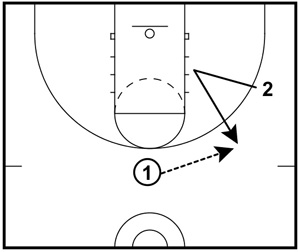
1. V-Cut:
The V-cut is a common cut that is used by a wing player to get open against man-to-man defenses.
There are two basic V-cuts a player can use to get open: a quick or short V-Cut and a Jam-Down, V-Cut.
When using the short V-cut...
- Start with a few medium speed steps toward the middle of court - go no lower than the third hash mark in the lane -- and then cut hard (in a shape of a V) back to the ball.
- When making the final leg of the cut, plant your inside foot hard, and step off quickly with your other foot to your foot.
- Prior to the making final cut, you want your hands in tight to your body but already set to catch the ball so you push-off your defender (legally) in order to help create space. If you extend your hands, it is an offensive foul.
- Once you catch the ball, rip-the-ball through and read what the defense does. If the defender backs off and you are in your range take the jumper.
- If the defender is still in your grill after the rip-through, attack the defender's front leg by getting your front foot past the defender with a low-quick, explosive first step. You can either go-to-the basket or pull-up for a J.
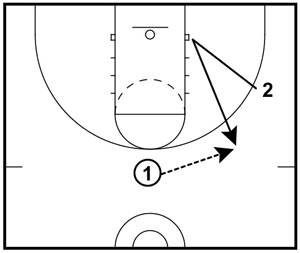
In the Jam-Down V-Cut, walk your defender down to the block. Then plant your inside and quickly make the V-Cut back to the ball.
Both V-cuts are best used on the weak-side of the offense for an isolation situation.
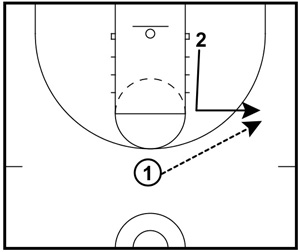
The L-cut is a great way to get open on the perimeter when starting on the low block. It is called an L-Cut because the cut looks like an L.
When making this cut, you don't need to be quick but you need exquisite footwork and use your body to hold off the defender.
- Take your defender up the lane - may go to elbow or cut it off short.
- Once you are ready to make the cut, get your top foot over the defender's foot and then use your body to nudge the defender a slight nudge to create space.
- Have your hands ready as you cut out to the wing.
- Rip-the-ball through after catching the ball, if you created enough space through your cut get ready to step into your shot for a jumper.
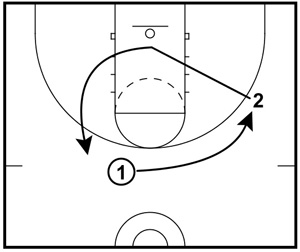
A shallow cut is a perimeter cut that is used when you are exchanging positions. It also can be used when replacing a player, who has vacated his position by dribbling or passing and cutting. You can use this type of cut versus man or zone defenses.
When using a shallow cut, you make an underneath cut and then popping out to where the player was previously located.
You can also use a shallow cut to relocate on the other side of the floor. For example, you are on the right wing and the point guard from top of the circle dribbles toward you. You make an underneath cut (through the lane) and pop out on the left side of the floor
Scoring options off a shallow cut are the same as if you used a V-cut or L-Cut.
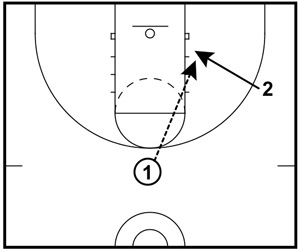
A dive cut is any cut toward the basket and will many times result in an easy lay-up for you or a teammate.
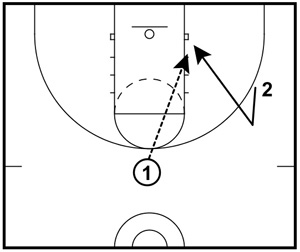
A back cut is used when you cut behind the defender and it is primarily used when you start out on the perimeter. It is a cut that should result in a great scoring opportunity for you or a teammate. It is also a cut where you may have to set-up your defender. You must use an explosive first step.
You can use the back cut in a number of situations. Against man-to-man defenses...
- You use back cuts when a defender is over playing you or denying you the pass on the perimeter.
- You can also cut when a teammate is dribbling at you. In this situation, you may have to take a few steps toward the ball before making the cut.
A great time to make a back cut is when you are on the “weak-side” wing - when the ball is either up top or in the high post (against man or zone defenses). The defense is adjusting to dribble or ball movement and preoccupied with helping/collapsing on the high post.
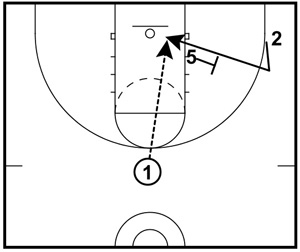
Another way you can use a back cut - either “weak-side” or “ball-side” - is when you are in the corner and rub your defender off a teammate (back-screen) who is stationed in the low-post.
For back cut to be an effective scoring option, timing between the cutter and passer must be perfect. The passer must be an accurate passer.
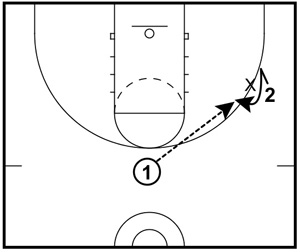
A face-cut is where you cut in front of the defender in order to be on the ball-side of the defender. It is typically used in a “give-n-go” situation and generally results in a layup for you or a teammate. Though there are times, where a short pull-up jumper is available.
Unless your defender is completely sagging off, you will likely need to set-up your defender before cutting. A quick jab-step or a couple of steps away from the ball should give you enough space to pull-off a face-cut.
The face-cut is a hard cut.
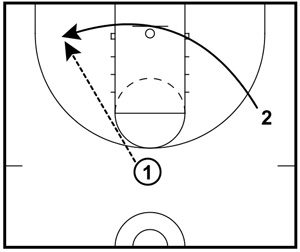
A deep cut is a cut where a wing player cuts underneath the basket from one side of the court to the other side. The best place for the cutter to end up is either in the opposite corner or for a 15-to-18 foot mid-range jumper between the wing and corner.
This cut is especially successful against zone defense because the defense often loses sight of the player cutting particularly if they are preoccupied with the ball and other players.
The deep cut can also be effective against man-to-man defenses.
When making a deep cut, you can use your low-post players as screeners by running your defenders into/off them. Or during a set play, they can set a screen.
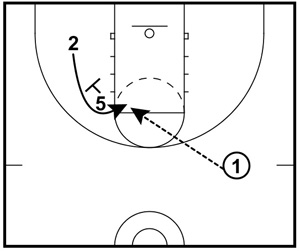
This type of cut is where a player curls around a screener. It is one of the most effective cuts to get a shooter the ball in ideal position to score.
A curl cut can occur anywhere on the floor from low-post to the three-point line.
In order for the cut to work, you must read the defender. If the defender is trailing, you then curl off the screen for the shot.
The key to a good curl is quick movements and staying low (around the screen). You must also come off the screen as tight as possible so that you don't take yourself into a help defender.
If the defender tries to go under the curl screen or switches, the best option could possibly be the next cut.
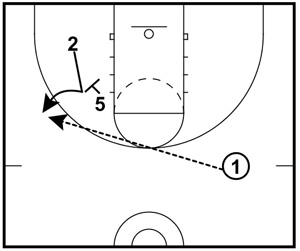
The flare cut is very similar to the curl cut. The only difference is if the defender takes away the curl, you flare (pop behind the screener) for a shot or drive.
A flare cut can also be used against zone defenses.
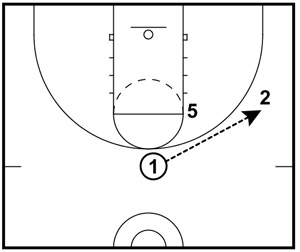
The UCLA cut involves two perimeter players along with a player in the high post. It usually results in a lay-up for the cutter.
It starts with the player on top of the key passing to the wing player and then going directly to the strong side block off of the high post's screen.
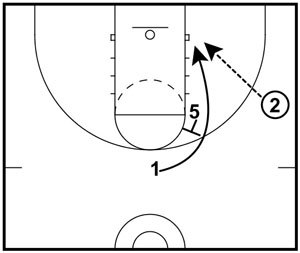
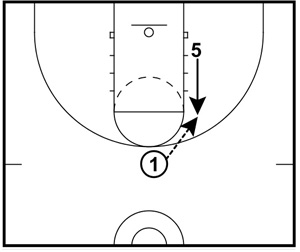
A flash cut is made by any player who starts in the post and flashes towards the ball in the high-post. The cut involves quick and explosive movements.
You have several options once you receive the ball in the high post. You can either pass it to a cutter/ hand off, kick it back out/reverse the ball or rip-the-ball through and pivot to get in triple threat position (drive or shoot).
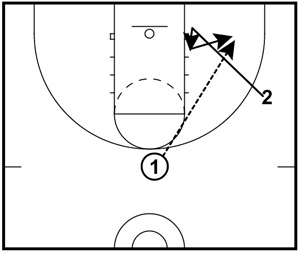
This cut starts out on the perimeter and involves either a post player or a perimeter player who has the ability to post up a smaller player.
The cut starts with the player on the wing making a quick cut down towards the low block. Once you are settled where you want to post, make a quick stop with your defender tight against your body. You then pivot, sealing the defender on your backside.
After sealing the defender, space out to the corner for a 15-to-18 foot jumper.
To get FREE 5 Drills to Build Your Motion Offense FAST, click the banner below
What do you think? Let us know by leaving your comments, suggestions, and questions...
|
|||||||||||||||||||||||||||




 Facebook (145k Followers)
Facebook (145k Followers) YouTube (152k Subscribers)
YouTube (152k Subscribers) Twitter (33k Followers)
Twitter (33k Followers) Q&A Forum
Q&A Forum Podcasts
Podcasts